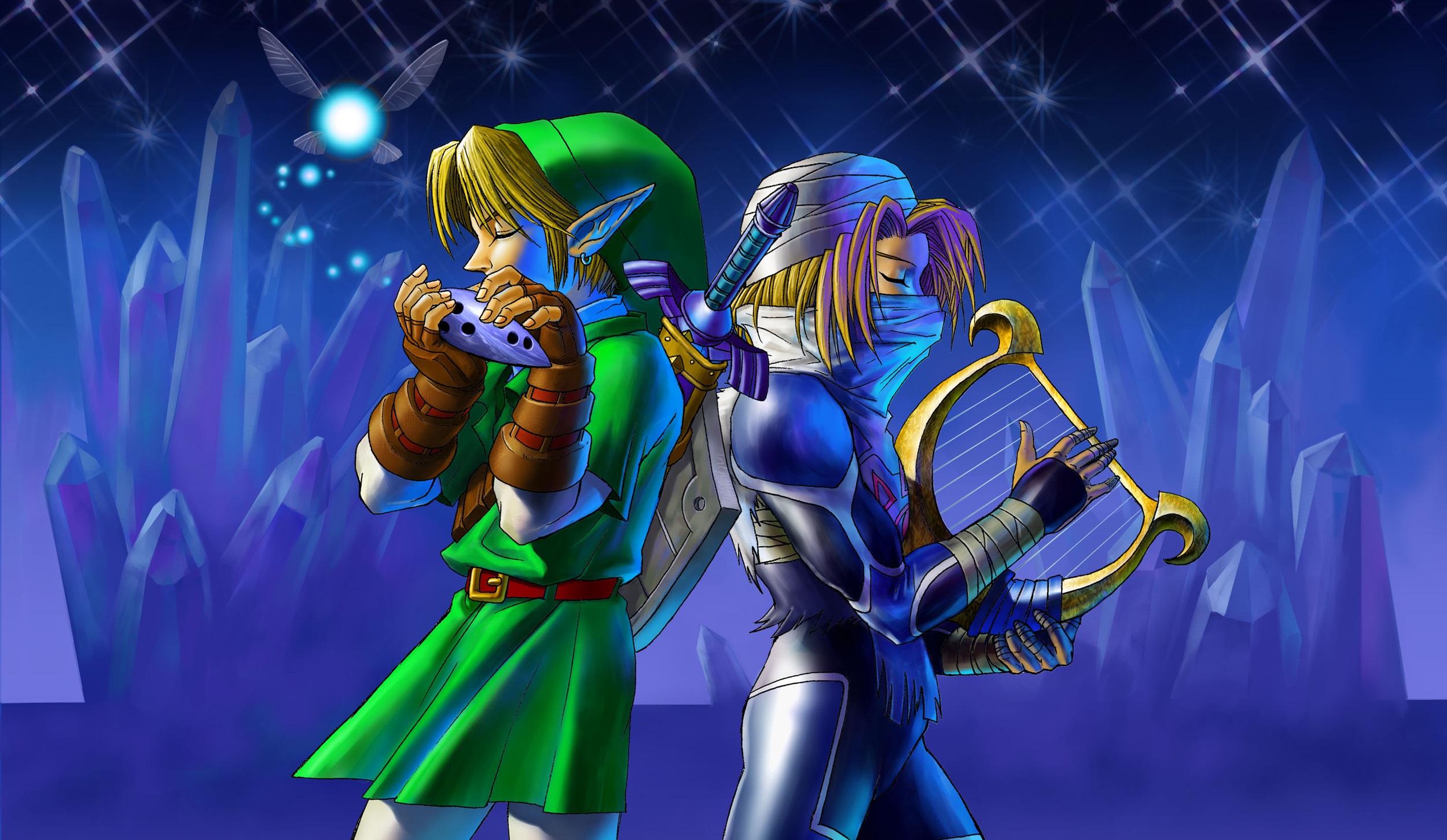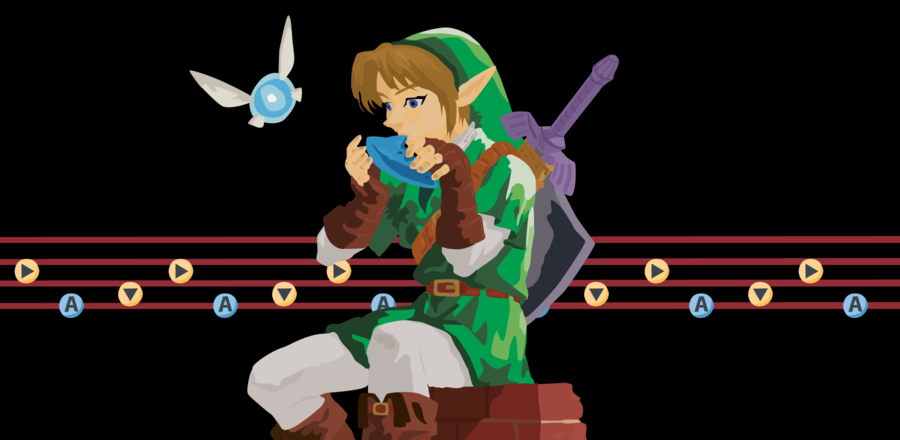Creating An Unforgettable Musical Score
Posted on November 19 2018 by Sean Gadus

Ocarina of Time is known for many things: bosses, dungeons, story, and gameplay innovations. Yet the one aspect of the game that I find most iconic is the game’s musical score. The legendary game includes a diverse and beautiful range of songs that represents some of composer Koji Kondo’s best work. From its dungeon themes, to its tense battle music, to the six-eight note ocarina songs, and finally to its area themes, the game’s soundtrack has stood the test of time as one of the most memorable scores in any video game. The game’s soundtrack has been covered by thousands of fans online, as well as in professional albums and live concerts in the two decades since its original release. Without a doubt, Ocarina of Time‘s music is one of the enduring aspects of the 1998 classic.
What many people forget about the soundtrack is the risks that Nintendo took with the musical score. While the game does reuse some classic themes from previous Zelda games, it leaves out some of the most iconic songs off of the soundtrack, instead opting for new compositions. Kondo created an assortment of iconic new compositions rather than resting on the laurels of his own and other composers’ previous work. Additionally, the game completely integrates its music into gameplay through the use of the ocarina, a make or break feature of the game that set a precedent for many future Zelda games. Instead of dooming the game, these musical risks resulted in one of most iconic soundtracks in video game history.
Hyrule Field – Creating An Iconic Overworld

Looking back at some of Ocarina Time’s 1998 reviews, one complaint relates to not using the original overworld theme from The Legend of Zelda and A Link To The Past. In 1998, when there had only been four previous Zelda games, the overworld theme was far and away the most iconic song in the Zelda series. Despite its importance, Koji Kondo and Nintendo ultimately chose not to include the song in the soundtrack. Instead, Kondo creating a new track to establish the feeling of adventure in Ocarina of Time‘s then massive Hyrule Field.
Ocarina of Time‘s Hyrule Field theme is renowned not only for its energy, but also for a relatively unnoticed innovation within the song. In the song, Koji Kondo created different stems or parts of the song that can be seamlessly integrated in different orders depending on certain in-game events and player actions. These different stems are reactive to the player’s movement and speed within the game. As the player moved through enormous field, the song would change pace and tempo depending on what the player experiences.
While Koji Kondo did not invent this technique, he used to perfection in his Hyrule Field theme. If the player pauses to survey Hyrule Field in a rare tranquil moment, the music would transform into a more peaceful version of the iconic tune. If the hero rushes through the field at full speed, the full adventurous splendor of the song would blast through the speakers. The game even has a distinct musical stem for battle or danger, a frenetic rhythm that warns the player of the danger that they are about to encounter.
This musical trick/effect ensures that the music in Hyrule Field always feels perfectly attuned to what the player is doing. It’s a trick that many players may not notice, but once you understand it, you begin to recognize how the technique helps immerse the player in the game world. If I am enjoying a peaceful moment of calm, the game will select the stem to fit my actions; if danger approaches, the musical cues will warn me. It’s a brilliant feature that has been used more often since Ocarina of Time‘s release, but its use in the N64 masterpiece is incredibly effective.
Brilliant New Compositions

Ocarina of Time does not rest on the laurels of its predecessors. Yes, the game reuses the classic Princess Zelda, Kakariko Village, and Ganon themes featured in previous games, but beyond this, Ocarina of Time‘s most iconic songs are new compositions. This is a choice that differentiates Ocarina of Time from its predecessors A Link To The Past, Link’s Awakening, The Adventure of Link, and the original Legend of Zelda. With incredible new songs by Koji Kondo, the game develops its own distinct identity, while also paying some homage to previous games by re-imagining classic Zelda songs.
One great example of creating iconic new compositions is the Lost Woods theme. A variation of “Saria’s Song”, the Lost Woods theme has become one of the most iconic and covered songs from the franchise. Koji Kondo’s new forest theme is energetic with a blistering pace, creating an instantly catchy and noteworthy addition to the Zelda musical pantheon. Despite the peppy melody and rhythm, the song still retains an air of mystery that fits the strange forest maze. Nintendo could have easily remixed the forest theme from A Link To The Past, but instead of reusing this old track, Kondo created a new theme that created a completely new tone for the Lost Woods in Ocarina of Time.
“Gerudo Valley” is another excellent example of how Koji Kondo created an iconic new musical theme. The song has a distinct spanish sound and rhythm, creating a lush atmosphere for the desert landscape and conjuring up a fittingly otherworldly or foreign feeling for the game. “Gerudo Valley” is a song that is completely different from anything else seen in previous Zelda games. Rarely has the series seen such a distinct soundtrack, and songs like these anchor the player in specific places within the game world.
Redefining Old Favorites

In addition to the incredible new compositions created by Koji Kondo for Ocarina of Time, the legendary composer also brought back several compositions from previous games. The most notable returning songs are Princess Zelda/The Maiden Theme, Gannon’s leitmotif, and Kakariko Village, and the soothing Fairy Fountain/Select Screen theme. All of these songs are first heard in the SNES classic A Link To The Past. And though Ocarina‘s soundtrack made use of these older tunes, it very effectively refined them in several interesting ways, creating perhaps the most recognizable version of each song.
One of the advantages of new hardware is new tools for the developers, designers, and composers to work with. In this case, Koji Kondo was able to redefine each of these tracks, only a single console generation after their introductions. While the Nintendo 64 is notorious for not having a sound chip, composers like Koji Kondo were able to get incredible things out of the Nintendo 64 in terms of sound. Anyone who played Ocarina of Time on the Nintendo 64 will remember the distinct sounds that came from the console, as they are incredibly nostalgic for returning fans.
The theme used for Princess Zelda benefits greatly from some of the increased instrumentation and capabilities of the Nintendo 64. The song sounds incredibly peaceful and beautiful, which creates a positive association between the player and the character of Zelda. This version includes the sounds of a harp in the background with the ocarina providing the soothing melody. It’s a beautiful version of the song, which is reused throughout the game in cutscenes and key moments. Since Ocarina of Time, this song has exclusively focused on Zelda, which differs from its original implementation in A Link To The Past where it was shared with that game’s Maiden characters.
Kakariko Village is a crucial location in Ocarina of Time for both Child Link and Adult Link. As a child, Link visits the growing village, which plays second fiddle to the bustling Castle Town. However, in the future, Kakariko Village has become the chief residency for the people of Hyrule. With the differences between time periods in mind, Kondo developed two versions of the theme, with slight differences in instrumentation in each version. The child version uses the sound of a guitar to created the atmosphere of a quaint and quiet town. In comparison, the adult version, called the orchestrated version, uses strings to convey the more sophisticated environment Link explores in his future. It’s a subtle change, but one that effectively illustrates the differences between the two time period within the game, as well as the state of village. Kondo clearly had more tools available to him to create different variations of the theme, allowing him to better tie his music to the events of the game.
Ganon’s theme receives the greatest benefit from its previous version. While the track was an effective and foreboding track in A Link To The Past, it is relatively simple due to the limits of the Super Nintendo. In Ocarina of Time, the track receives two distinct renditions, one which is similar to the SNES version, which is used in cut scenes, and a chilling Gothic rendition used in the game’s final dungeon. The version from Ganon’s Castle is an incredibly haunting composition, with the N64 attempting to recreate the chilling sounds of a Gothic organ. The version in Ganon’s Castle instantly conveys the incredible evil that Link is surrounded by. As Link ascends towards his final climactic showdown, the seemingly endless runs of chilling notes from the organ expresses a sense of power and overwhelming malice.
Integrating Music Into Gameplay

One of the largest risks in Ocarina of Time is the integration of music in the form of the Fairy Ocarina and the Ocarina of Time. The game requires players to learn and play songs in game, with the A and four C buttons on the Nintendo 64 Controller. These songs are required to complete various tasks including fast travel, puzzle solving, and progression.
This decision was a tremendous risk for Nintendo. If the ocarina had not worked, it could have harmed the gameplay and tempo of the overall experience. Koji Kondo previously stated in an Iwata Asks that creating a working ocarina in the game was a huge challenge for the composer. The game had a limited amount of buttons and notes that could be assigned to these buttons. With this in mind, Kondo had to create memorable songs from very limited combinations of notes.
These short tracks may be simple, but they ended up being incredibly memorable and diverse. Each of the six warp themes, “The Prelude of Light”, “Minuet of Forest”, “Bolero of Fire”, “Serenade of Water”, “Nocturne of Shadow” and “Requiem of Spirit” use different tempos and tones to capture their respective temples. Additional songs like the “Song of Time”, “Sun’s Song”, “Epona’s Song”, and “Song of Storms” are memorable additions to an already lush soundtrack. Within his limited range of notes and chords for the ocarina, Koji Kondo created a dozen brief but incredible musical themes.
Conclusion

Ocarina of Time is a game known for being iconic, with an influence and legacy that is larger than life. Its legacy of music looms large like the Desert Colossus over many other video game scores. It’s an incredible collection of music, created by designers and a composer who took risks that could have derailed the game, but instead gave the game one of its most significant and lasting achievements. Mixing old favorites with hugely popular new songs, Koji Kondo and Nintendo ensured that the game would live on for years to come. In closing, I believe that twenty years from now, I will still be listening to Ocarina of Time‘s music, marveling at one of the most iconic soundtracks to ever exist.
Sean Gadus is an Associate Editor at Zelda Dungeon. He loves playing video games, reading books, watching movies and geeking out about all things Star Wars, Batman, and Harry Potter. His first Zelda game was Ocarina of Time. He is an amateur writer and a professional Zelda fan.

Sean Gadus is a Senior Editor at Zelda Dungeon. His first Zelda game was Ocarina of Time, and he loves all of the 3D Zelda games from 1998-2011. He is currently replaying the narrative ghost story Oxenfree, and taking his first stab at playing Dark Souls. He wants to help build a kinder, more compassionate world. You can check out his other written work at The-Artifice.com.



